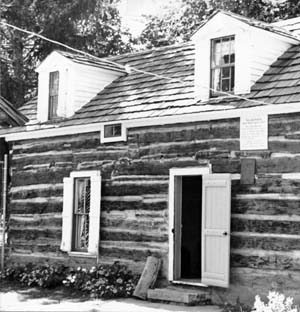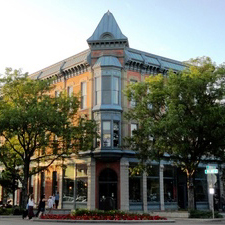News Flashbacks
Fountain, Many Other Mementos Of Past Stand in Lincoln Park
Author Unknown
Fort Collins Coloradoan 1963

Not all the mementos of the last 100 years of Fort Collins history are contained within the walls of the Pioneer Museum on the Peterson Street side of Lincoln Park. A casual stroll through the park area between the museum and the city library discloses others that are seldom observed.
One of these is a fountain erected "in honor of Mrs. Eliza M. Tanner, pioneer teacher, temperance crusader, ardent worker for animal protection." Another is a pin oak designated by a low monument as a "Memorial Tree presented in honor of the Grand Army of the Republic by its Auxiliary, the National Woman's Relief Corps."
Fort Collins' unit of the GAR organization of Union veterans of the Civil War, was named as the "Rock of Chickamuaga." The post's last surviving member was George Metz, who died several years ago.
Memorial to Maine
Other remainders of earlier times to be found in the same area include a bronze tablet mounted on a granite stone and inscribed as a memorial to the U. S. battleship Maine, which was sunk in Havana harbor Feb. 15, 1898, preceding the Spanish-American War.
And there is a huge circular water trough, made of local red sandstone, which once stood in the middle of College-Mountain Avenue intersection for the quenching of horses' thirst. Later it stood on East-Mountain Avenue near its Matthews Street intersection.
Also to be found is a large millstone, hollow in its center, taken from an early-day flour mill. Near the library stand the eight wooden pillars salvaged from the mansion that once stood on the site of the Safeway store on South College Avenue and Mulberry Street.
This was originally the home of Corwin W. Welch, the town's leading dry goods merchant of his day and one-time president of the First National Bank. Until it was demolished in 1951 to make way for the store it was the home for many years of the late Mr. and Mrs. Charles R. Evans.
First Log Cabin
Standing near the museum are two of the first log cabins built in this area. One is the "Aunty Stone cabin," built in 1864 on the south side of the 300 block of Jefferson Street. It was used as a boarding house for Army officers stationed at Camp Collins across the street, later as a hotel and as the settlement's first school house, taught by Mrs. Elizabeth Stratton. The other is the Antoine Janis cabin, built near Laporte by the first white man to settle in this area.
The fountain which commemorates Mrs. Tanner (also spelled "Tannar"), was erected after her death at the age of 98 on Oct. 11, 1938. It was provided with efforts of a committee composed of Mrs. Roy A. Portner of 322 West Laurel Street, Mrs. A. B. Miller and Mrs. S. W. Moore, who died recently, aided by Richard S. Baker, assistant city manager.
In her will on file in the County Court, Mrs. Tanner made a constitutional bequest to the national educational fund of the Women's Christian Temperance Union. She asked relatives receiving primary bequests to give a tenth of the income from them for "Christian, humane, peace, and temperance work."
Niece of Chief Justice
Mrs. Tanner was born Eliza Jane Marshall, a niece of John Marshall, who was U. S. chief justice from 1801 to 1835, on July 17, 1840, at Rochester, Ohio. As a student at Oberlin College in Ohio she collected the autographs of the young men of her class who had enlisted in the Union Army. Her husband was a Union Army veteran.
The account of her death in the Express-Courier issue of Oct. 13, 1938, related that she was "one of the few surviving 'crusaders'" of the WCTU and a life member of the Cache la Poudre chapter of the Daughters of the American Revolution. She was active in the First Presbyterian Church and its Missionary Society.
She came to Fort Collins in the early 1900's from eastern Colorado, where she took up a home stead claim in 1902. She had taught school in Ohio and Nebraska. She came here to enter her son Hubert in Colorado State University.
Mrs. Portner, who was executrix of Mrs. Tanner's will, recalls that the son died soon afterward during a local epidemic of typhoid fever.
Mrs. Tanner worked in local temperance causes and in that of humane education in the public schools before establishment of the Colorado Humane Society.
She rented rooms in her home at 717 Matthews Street to college students.
The fountain erected in her memory was made of native "bull quartz" from the mountains west of Horsetooth Mountain by the late Roy Nye, a stone mason. At its foot are recesses containing water for the benefit of passing dogs-a further testimony in her regard for animals.


Preserving the history of Fort Collins, Colorado & the Cache la Poudre region





